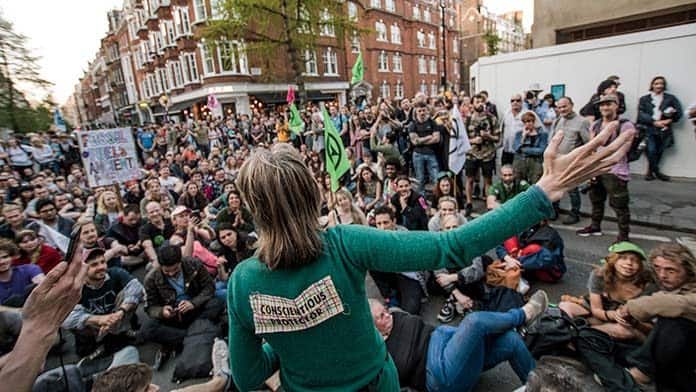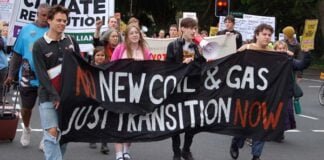Civil disobedience can strengthen the campaign for climate action, but on its own it lacks the power to bring fundamental change, writes James Supple
In April tens of thousands of Extinction Rebellion protesters occupied the streets of central London. The heart of the city was shut down, with over 1000 people arrested as part of a major civil disobedience action.
TV channels and the mainstream media were covered with reports on the protests, their call to declare a climate emergency and to implement radical solutions.
This disruptive action did not isolate the movement, but has inspired many others to act for the first time. The birth of this new radical movement for climate action is a breath of fresh air.
It has now spread to Australia, with Extinction Rebellion activists here set to join an international “week of rebellion” beginning on 7 October.
Protests in Brisbane have already disrupted traffic on several occasions, including an action where 72 people were arrested on one day in August.
Civil disobedience is a way of stepping up the level of disruption and raising the social and political cost of protest action. It involves consciously breaking the law and risking arrest to either shut down or disrupt a specific target.
Many campaigns have used civil disobedience tactics—from the militant protests that tried to storm US consulates during the Vietnam War to the defiance of Joh Bjelke-Petersen’s ban on the right to march in Queensland in the 1970s to the Bentley blockade against coal seam gas mining in 2014.
But such tactics are not always successful. Unless such actions are part of a strategy to draw in wider groups of people, they can leave activists isolated, and hit with large fines and jail sentences.
Environmental campaigns in Australia have often used civil disobedience tactics such as locking on to gates or mining equipment. But these acts can only be carried out by small, specially trained groups of activists or individuals.
What distinguished the Extinction Rebellion actions in London is that they involved mass civil disobedience, consciously open to the involvement of large numbers of people.
The same was true of the S11 blockade of the World Economic Forum in Melbourne in 2000, which involved up to 10,000 people, and the 1000-strong refugee protest that tore down the fences at the Woomera detention centre in 2002.
This kind of civil disobedience is much more effective and can be openly advertised and argued for.
But this kind of mass action is only possible where civil disobedience is organised as part of a campaign with a broader base of support. Without this it is more difficult to defend activists from state repression and ensure those involved in breaking the law are not isolated.
That means direct action needs to be combined with mass protest marches and other events capable of drawing in a wider layer of supporters.
At its best, civil disobedience can deepen support for the movement and shift the debate in society to the left. By bringing home the urgency of the situation and showing the risks activists are prepared to take to demand change, it can push others to reconsider their own point of view and willingness to act.
Actions during the Vietnam War such as “aiding the enemy” through students at Monash University collecting money for the Vietnamese National Liberation Front, in defiance of university authorities and the law, helped to drive the movement forward through shifting the debate and shifting public opinion against the war.
Limits
But it is a mistake to think that civil disobedience on its own can bring down governments or force the kind of action we need on climate change. This underestimates the power of capitalism and the state—and the lengths to which they will go to in order to defend their wealth.
Extinction Rebellion has popularised the idea, taken from US academic Erica Chenoweth, that 3.5 per cent of the population taking non-violent action is the key to toppling governments or forcing major social change.
Extinction Rebellion founder Roger Hallam argues that, in the face of sustained non-violent civil disobedience, “After one or two weeks… the historical records show that a regime is highly likely to collapse or is forced to enact major structural change”.
But this claim has no historical basis at all.
The historical experience of civil disobedience shows that there is a limit to its power to force change.
Gandhi’s campaign of civil disobedience against British imperialism is the most frequently cited example of the power of this kind of action.
But it was not non-violent protest that drove the British out of India but mass strikes, mutinies and armed uprisings.
Gandhi called off the “Quit India” movement he had launched in 1942-3 after it led to clashes with the police and the army, peasant rebellions and attacks on police stations.
Britain finally withdrew from India following a fresh wave of protest involving a naval mutiny in 1946—an action Gandhi condemned. The mutiny triggered strikes in its support across the country, including a general strike of over 300,000 workers in Mumbai.
Martin Luther King’s movement against the racist Jim Crow laws in the US South in the 1950s and 1960s is another famous movement of non-violent resistance.
It saw mass protests and sit-ins confront racist police determined to maintain segregation.
But after initial progress in the South around civil rights, the fight spread to mass uprisings in black ghettos across the US.
King himself began to look to more radical action as the civil rights movement ran up against the limits of its ability to deliver serious reforms. King was assassinated as he launched his anti-poverty campaign by backing a garbage workers strike in Memphis, Tennessee.
Toppling governments
Civil disobedience can help ignite a political crisis in society, but on its own it is not capable of toppling governments or transforming society.
The revolutions from below that have seen governments toppled in recent times, in places like Egypt in 2011 or Sudan in the last few months, have involved mass strikes as well as forms of civil disobedience like the sit-in occupations of Tahrir Square in Cairo or in front of the military headquarters in Khartoum.
But in both countries the old state, in particular the army, has been able to regain control through a process of small concessions and repression against the mass movement.
But these revolutions have given us a glimpse of a kind of power from below that is capable of forcing real system change, and deepening the scale of the challenge to the old order posed by the movement.
In Egypt workers’ strikes were crucial to forcing the army to abandon its support for the dictator Hosni Mubarak.
And in Sudan general strikes called by the Sudanese Professionals Association, involving teachers, academics and doctors, also played a key role.
The working class, the millions of ordinary people in the factories, offices, hospitals and other workplaces, does all the work that keeps society running.
When Sydney train workers threatened to strike for 24 hours last year it demonstrated the potential power of strike action—as employers warned of the threat of economic damage to the whole economy from workers forced to stay at home for the day.
There is a fundamental class divide in society between workers and bosses. It is workers’ labour on which the wealth of society and the profits that are central to capitalism ultimately depend.
When workers go on strike they paralyse the ordinary operations of the economy and shut off the flow of profits. This is the most powerful form of collective action there is.
The Climate Strike has helped to raise the need for workers’ strike action over climate change, with high school strikers inviting workers and trade unions to join them on 20 September.
Many unions have endorsed the Climate Strike and organised contingents for the day. These are important first steps to drawing more workers into the climate movement.
Climate activists also need to support every strike and union campaign fought around demanding better wages and conditions at work.
Capitalism’s drive to increase profits means a constant effort to drive down wages and push people to work harder.
This means that the system that is responsible for climate change also forces workers into struggle to defend their own standards of life.
Strike action can not only shut down business as usual but also begin to show how ordinary working people can take the control of society into their own hands.
A general strike that shuts down the economy for any extended period forces workers to make decisions about how to meet people’s basic needs—such as where to restore power and how to distribute food.
In revolutionary situations in the past such as Chile in 1973, Poland in 1980 or Russia in 1917 this has led to the formation of new grassroots democratic structures to discuss how society should be run.
Such a truly democratic society, run in the interests of ordinary people and the planet instead of the dictates of capitalist profits, could begin the rapid transition needed to deal with climate change.
Civil disobedience cannot be an end in itself. It needs to be used to help build a movement around climate change capable of drawing in the social force with the power to revolutionise society—the working class.






